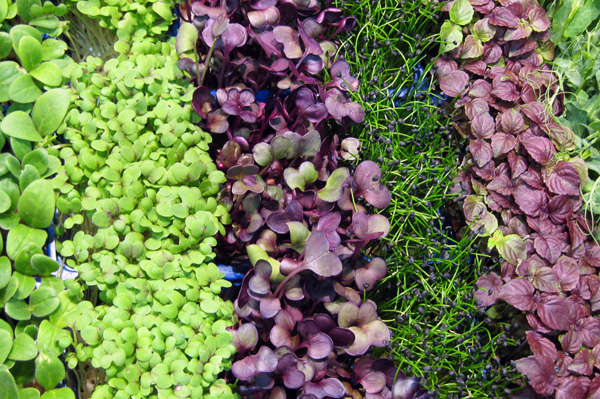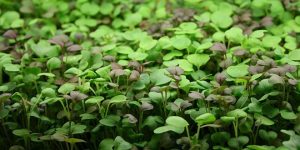Microgreens are a trend that’s sticking around, and for good reasons. They’re delicious and insanely refreshing, highly nutritious, and easy to grow almost year-round. We grew some at Petaluma Bounty to include in our CSA boxes, and I continue to grow just a few successions each year at B-Side Farm just for personal lunch consumption.
So what exactly are microgreens? Basically, they are very tender young plants that are harvested way earlier than your typical greens. Any new baby green can be considered a microgreen – kale, choy, lettuce, cabbage, or really anything you can think of that would normally be eaten as a mature leaf. Whereas many of these mature plants would need to grow in the greenhouse and then outside for weeks before they are big enough to harvest, microgreens are ready in about a week – making them quick and easy, and the perfect crop to experiment with if you’re new to growing. Most farms that produce microgreens for mass market do so in trays in the greenhouse, though I’ve grown them outside as well.

Microgreens Are A Super Food!
Adding microgreens to your diet is a quick and easy way to step up your daily nutritional intake. While all different, they are reported to have higher levels of vitamin C, vitamin E, vitamin K, carotenoids, beta-carotene, protein, phenolic compounds, and antioxidants than their mature counterparts. In fact, NPR reported that new studies show many microgreens possess anywhere from four to six times more nutrients than if they were grown to maturity. You can incorporate microgreens into salads, smoothies, or just eat them solo with a little lemon juice as a great snack.
How to Grow Microgreens Outside
If you want to give a go at growing your microgreens outside in the garden, first follow my standard rules for soil preparation. In a nutshell, wait till the soil is at a good moisture level for being worked. An easy way to determine appropriate soil moisture is to scoop up a handful of soil and form it into a ball in your hand, and then bounce that ball up and down a few times. If the ball breaks apart pretty easily, your soil is at a good moisture level. If it stays a tight ball, let it wait a few days and then try again. If it was too dry to make a ball in the first place, then turn on a sprinkler for a few hours, let the ground saturate, and wait a few days. Working and digging around in soil that is either too wet or too dry can have lasting detrimental effects.
So, when your soil is ready to go, loosen your garden bed with a fork or a shovel, adding a small amount of compost if you think it needs it. Then make sure to rake the surface smooth, pulling any large clumps off the bed and flattening any dips or hills.
Then simply scatter your seeds by hand. The goal is to have the seeds land about ⅛ inch apart – but honestly, who can eyeball that?! Just aim to have a fairly dense layer of seeds, so that you can still see the soil surface below, but there is more seed than soil (picture a thin layer of snow). When sowing by hand, I’ve learned that the more quickly your hand moves, the better. If you think you have great accuracy and precision by slowly placing seeds on the ground or letting them spill out handfuls at a time, you might be mistaken. It’s best to start with a small handful and, holding your hand about 6 inches above the soil surface, move it quickly yet smoothly over the surface as you spill out the seeds, replacing the handful as needed. While not rocket science, it takes some practice to get it right.

Once you’re happy with your layer of seeds, use the same hand-scattering method to cover them with about ¼ inch of fine soil – no big clumps or rocks, as the seeds will have a harder time pushing through the surface.
As with any seedbed, water the surface with a gentle wand until thoroughly soaked through. For the next few days you’ll want to make sure to keep the soil surface completely moist. To make sure you’re not over-watering, you can wait till about ⅓ or ½ of the soil surface starts to dry down before you water. As the seeds germinate and grow into little plants, you will want to water less frequently but more deeply, roughly once or twice a day.
To harvest the microgreens, wait until they have developed one set of true leaves – this usually takes around 10 – 14 days. These leaves look different from the cotyledons or seed leaves, which are the first leaves that develop. Use a pair of sharp scissors to cut the greens just above the soil surface. Don’t worry about re-growth, as it’s not worth trying to get more than one cutting from any succession of microgreens and in fact, the plant is too small after you cut it to be able to put on new growth. To have a continual harvest, simply repeat these steps every week or two.
For a more in-depth, professional method for growing larger quantities of microgreens in a greenhouse, check out my earlier post on how to grow microgreens.







 Family
Family

